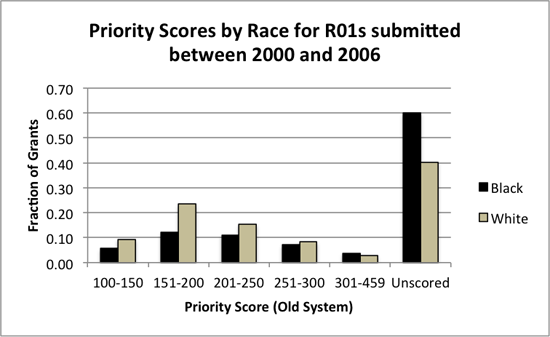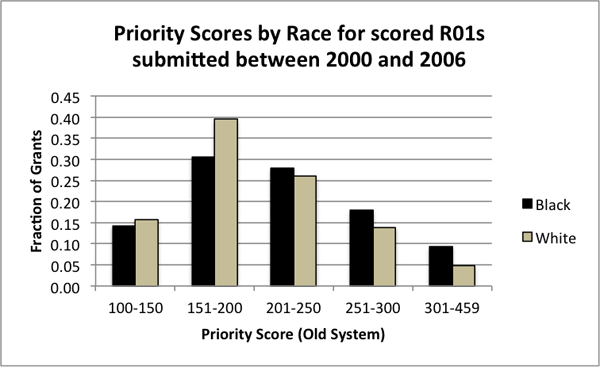Last week Science published a paper describing the results of an NIH-sponsored investigation into the impact of a scientist’s race on the probability of that their grants will be funded.
The findings were striking:
After controlling for the applicant’s educational background, country of origin, training, previous research awards, publication record, and employer characteristics, we find that black applicants remain 10 percentage points less likely than whites to be awarded NIH research funding.
This result has led to some degree of hand-wringing and pledges to act from the NIH, along with calls to stamp out presumed racism in the peer review process from prominent editorial pages and Congress (and here).
I have no reason to doubt the data presented in the paper. But the interpretation by the authors, media and others are alarmist and incomplete. Rather than exposing lingering racism in the NIH peer review process, I think the data paint a fairly accurate picture of the current state of efforts to increase minority representation in the sciences – highlighting remaining challenges, but also noteworthy accomplishments that the paper and discussions about it have completely ignored.
First, let’s look at the data. The key finding is shown below (I’ve plotted data from Table S1 of the paper. For those unfamiliar with the NIH peer review process, all applications are reviewed by 3 scientists who assign a preliminary score – in the case of these grants from 100 to 900, with 100 being the best – grants with a preliminary score above a threshold are “triaged”, the remainder are discussed with the larger panel of reviewers, after which final scores are recorded):
The effect is undeniably strong: 60 percent of R01 (the standard research grants that support most labs) applications from black PIs are triaged, compared to 40% for white applicants, and far fewer black PIs get scores in the coveted 100-150 range where grants are likely to get funded.
But a few things are worth noting. First, of the applications that are discussed in study section (i.e. not triaged), a roughly equal proportion of applications from black and white PIs get scores between 100-150.
This detail should not be ignored. NIH funding is intensely competitive. Fewer than 10% of all applicants get this kind of score. Far more than just a passing grade, a score better than 150 reflects shared enthusiasm amongst the reviewers and other panelists for the project and the investigator – that they think the proposed work is technically outstanding, innovative and important, and that they have a high degree of confidence that the applicant will accomplish what they have set out.
While the total number of black PIs receiving this kind of acclaim for their work remains smaller than ideal, these results highlight the growing number of tremendously talented and accomplished black researchers rising through the ranks of American science, and serves as a testament to these individuals’ intellect, creativity and hard work. We should celebrate the remarkable success in diversifying American science that their accomplishments represent.
This is important to point out because people reading the paper and most of the discussions surrounding will get the incorrect impression that black scientists face an almost hopeless battle to get funded. And if this misconception were to spread unchecked, it could easily become a self-fulfilling prophesy, with the best students and postdocs reluctant to join labs whose prospects for funding – and thus success – they believe to be low.
Of course the success of some black applicants does not mean that NIH peer review do not give worse scores to grants whose PIs are black than they would to the same proposal from a white scientist. The NIH is (appropriately) doing experiments to investigate this possibility, but, in my service on study sections and other review panels I have never seen anything that suggests race is factoring in to people’s decisions in any way. The NIH peer review system has its flaws, but reviewers take the meritocratic ideal seriously and really do try to be fair. Furthermore, most researchers I know share the goal of diversifying the field, and seem unlikely players in the kind of pervasive racism it would take to explain the observed differences in outcome.
I am not arguing that there is no racism in science. I just don’t think it manifests itself in the grant review process. Consider, for comparison, the success of women in the granting process. Much has been written about the challenges women face in building successful scientific careers, and few would doubt that misogyny persists in the biomedical sciences. But, as researchers using the same database of NIH grant applications that led to the race results recently concluded in a far less high-profile recent study, success rates for men and women were not significantly different in most award programs. While obviously gender and race are not equivalent, I think this argues that the the NIH peer review process is actually fairly equitable, at least in the narrow sense of scoring grant applications.
So, if I don’t believe peer review is pervasively racist, but I believe the data in the paper, I have to believe instead that NIH study sections find that grant applications from black scientists are – on average – marginally less impressive than those of their comparably experienced and accomplished white colleagues. But should this really be that surprising? To expect perfect equity, you have to assume that aspiring black and white scientists have – again, on average – had equally good educational and training opportunities, and that the best and the brightest black students are equally likely to pursue careers in science as their white peers – two things no reasonable person would argue are true. Indeed it is precisely because of these problems that the NIH has put extensive resources into encouraging minorities to enter science and to promote their careers. I strongly support these efforts, but the NIH can not magically erase the effects of disparities in education and research opportunities. And unless you think these efforts have been universally successful, the results presented in this paper should not be surprising.
This is why, rather than looking at the data presented by Ginter et al. as a shocking expose about racism in biomedical science, we should instead look at it as a measure of the progress we’ve made towards diversifying American science: revealing clear remaining challenges that must be addressed, but also highlighting the tremendous accomplishments of the growing number of black and other traditionally underrepresented biomedical scientists.
And I hope it’s not too late to change the message we take from this work. The most disheartening statistic in the paper is not the success rate of black grant applicants, but the fact that there are so few of them (only 1.4% of applications were from black PIs). Rather than discouraging aspiring black scientists by portraying a field filled with insurmountable obstacles, we should emphasize that biomedical science offers them the opportunity to be judged not by the color of their skin, but by the content of their R01 application.


9 Comments